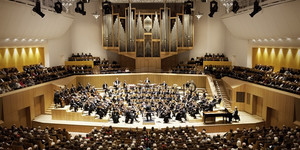
A City and its Orchestra
If you've ever been to a Bamberg Symphony concert, you'll recognize the scene: about an hour before the start, you see women and men with instrument cases on their backs cycling along the river Regnitz, followed soon after by the first concert-goers. People saunter past you on the old City Hall Bridge, along the shore opposite »Little Venice« and over the slender walkway to the Concert Hall. Calmly ensconced, you treat yourself to a last glass, then take your seat and surrender completely to the music.
It's the product of centuries, this life of inner calm and serenity in the medieval World Heritage city that is Bamberg, whose origins go back to 10th century. By comparison, the Bamberg Symphony, founded in 1946, is barely out of its infancy, yet this world-class orchestra is extremely busy, giving several dozen concerts every season, enriching Bamberg's cultural scene and broadcasting its name to the wider world on its many tours. You’d hardly think it, to see the players cycling without a care in the world through our medieval city's picturesque streets, as you walk or cycle to the concert yourself. In Bamberg, everything's just a skip away.
And after the concert? Prolonged applause, no one jumping up manically when final chord has barely died away to beat everyone to the car park or catch the last train. On the way home, you gently wind down, do a post mortem on the Schumann, Beethoven, Mahler or the contemporary piece and maybe end the evening with a smoky »Rauchbier« or a glass of Franconian wine in one of Bamberg's many cosy taverns.
That's Bamberg for you – this gem of a city which we're always so happy to return to after a long tour: Bamberg, UNESCO World Heritage city in the heart of Europe, with its stunning architecture, thousand-year history, its Cathedral and life-sized 13th century statue of the Bamberg Knight, its seven hills and richly carved tomb of a Holy Roman Emperor and Empress. Surely the smallest of the world's great musical cities, it's a genuine jewel, which shapes our daily lives, just as it invites outsiders to swap theirs for ours, after which they're never the same again.
Bavaria's Best Concert Hall
During the concert itself, he doesn't yet know that what he's hearing will leave a lasting impression on him. And a lasting legacy… The time is the 1960s: Yasuhisa Toyota, not quite 18, is listening to our Orchestra on tour in Japan. Exactly where, playing what and under who, history doesn't relate. But something must have captivated the attentive youngster, or he wouldn't have agreed, decades later, to give the acoustics of the Joseph Keilberth Hall a complete revamp.
Because it isn't at all Yasuhisa Toyota's usual practice, to improve the sound of a concert hall after it has been built. Japan's star acoustician is in demand all over the world, wherever an orchestra needs a space in which both performers and public can be intimately involved in the musical goings-on. He was responsible for the acoustics of Tokyo's Suntory Hall and the Walt Disney Concert Hall in Los Angeles, to name just two of his most high-profile assignments, and he has had a hand in those of the soon-to-be-opened Paris Philharmonie and Hamburg Elbphilharmonie.
So Bamberg's Concert Hall is one of exceptionally few instances of retroactive work on a hall in Yasuhisa Toyota’s career. It was Toyota himself who brought up that concert in Japan, in a 2008 interview, and remembered how »deeply impressed« he'd been. A memory with positive consequences – for all of us!
By the turn of the millennium, the Joseph Keilberth Hall, opened in 1993, had become a problem for the Bamberg Symphony. It's hard to exaggerate the leap forward the Orchestra had made when it moved from the high-vaulted nave of the medieval Dominikanerbau into its modern »shoebox« – not remotely derogatory, by the way, but industry jargon for concert halls with an extended cuboidal shape.
Lording it over the Hall's stage is the »queen of instruments«, an organ built by the firm of Georg Jann in 1992-93 and unveiled on 9 October 1993. The Jann organ made it possible to present the whole concert repertoire for organ, from the baroque to today, in the best possible setting. And it's the ideal instrument for large, late romantic orchestral scores and oratorios, in which it isn't merely part of the orchestral texture but often has a substantial solo role. It boasts an impressive palette of romantic colours and an enormous dynamic range – from a barely audible whisper to the primal power of its tutti, which allows it to hold its own with a large symphony orchestra.
But over the years the Joseph Keilberth Hall had begun to reveal defects which sapped the sound of our Orchestra. The space was not originally intended solely for symphony concerts, with the consequence that acoustic parameters were not given top priority at the planning stage. In addition, computer technology was not then mature enough to plot the acoustics in advance down to the last detail. The result: when playing alongside each other, the musicians couldn't hear each other properly, and the acoustic was too cold and direct, on top of being brass-heavy.
To remedy this, Yasuhisa Toyota had risers installed, made out of yellow cedar which is light and vibrates delicately, had openings cut into the rear wall of the stage which can be closed off with sound-insulating material when needed, and had improvements made to the Hall's ceiling. Off came the varnish; and the floor of the stage was also stripped of its wood varnish, since this used to swallow the sound. Underneath the stage, half of the metal supports were removed, suddenly making low orchestral frequencies much more audible and present, palpable even.
Now, with the new set-up, everyone is happy, both players and public. The musicians hear each other much more clearly than before, and almost intertwine within the orchestral texture. They can see each other better too, since they sit much closer together and are better organized than in the previous lay-out. This also makes the Orchestra a feast for the audience's ears – and eyes: the revamped stage, with its more compact seating arrangement, translates into a sound that is much more balanced, but also internally more nuanced, and with more roundness and depth than was the case before.
Add the new foyer, built by the renowned Hamburg designer Peter Schmidt, a long-standing partner of the Orchestra, and the result is a truly inviting architectural whole, in which the Bamberger Symphony now truly sets the tone as it should.


